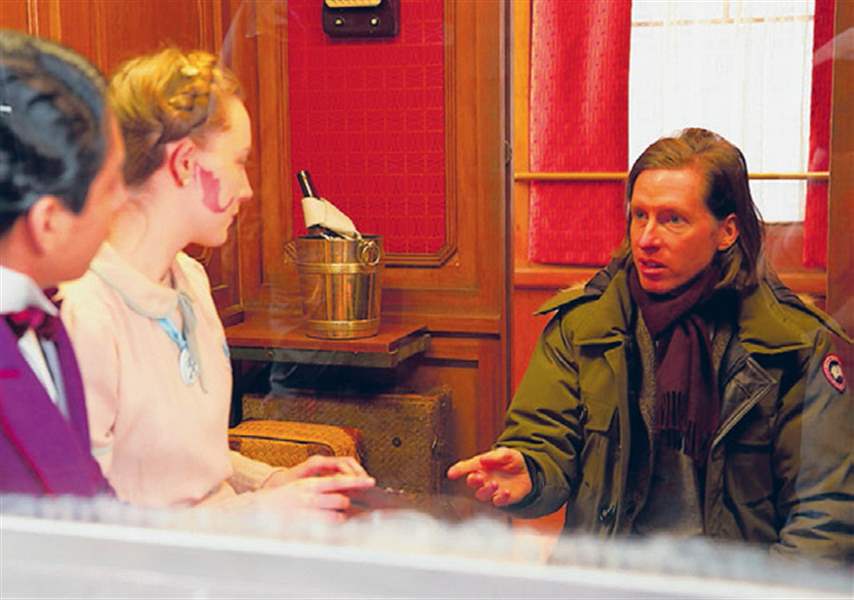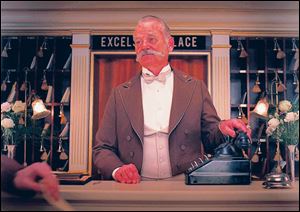
ENTERTAINMENT
Screwball intrigue fills the ‘Grand’ new European jaunt from Wes Anderson
3/11/2014
Wes Anderson sets up a scene in ‘The Grand Budapest Hotel.’
FOX SEARCHLIGHT PICTURES

Wes Anderson sets up a scene in ‘The Grand Budapest Hotel.’
LOS ANGELES — More than just about any other major American filmmaker working today, writer-director Wes Anderson doesn’t so much make movies as create worlds.
Each of his films takes place in its own strange sovereignty, whether the Texas prep school of Rushmore, the train running through India in The Darjeeling Limited, or the island hideaway for a pair of adolescent lovers in Moonrise Kingdom.
His latest, The Grand Budapest Hotel, is set in the fictional country of Zubrowka. Though the story skips through multiple time periods, the main action is set in the 1930s against the backdrop of impending war, as a meticulous yet rambunctious concierge known as Monsieur Gustav H. (Ralph Fiennes) takes on a young refugee named Zero Moustafa (Tony Revolori) as lobby boy and protege. The cast also features F. Murray Abraham as an older Moustafa, Tom Wilkinson, and Jude Law as an author at different ages and an impressive ensemble including Bill Murray, Tilda Swinton, Owen Wilson, Saoirse Ronan, Edward Norton, Jason Schwartzman, Mathieu Amalric, and Lea Seydoux.
Along the way there is a contested inheritance, a missing painting, a brief imprisonment, a few separate chases, a secret society, and the impending menace of an invading army, giving the film an air at times of a farcical caper. Fiennes in particular conjures a surprising spirit of screwball grace.
The film, which opened in limited release Friday, has a rather complicated framing structure that creates a story within a story within a story within a story. (Anderson, a two-time Oscar nominee for screenwriting, shares story credit with his friend, the artist Hugo Guinness.) The film is, among other concerns, about mentorship, the end of eras and how the traumas of youth can be carried forward through adulthood. Also, pastries.
Themes of mortality, the fragility of romance and the importance of approaching life with a sense of adventure have also pulsed through Anderson’s previous films — frequently seen through the prism of naive and then pained youth. The films are swathed in his bedrock style of deadpan comedy and aching melancholy within meticulously constructed visuals. Anderson and his longtime cinematographer, Robert Yeoman, shot “Budapest” on 35-millimeter film and switched aspect ratios to signal changes in time periods. For Anderson, each film is “starting from scratch,” meant as a renewed exploration both for him as a filmmaker and audiences too.
“To me each one is just a completely new ball of wax, if I’m using that expression properly. I’m not really using that expression properly. But anyway, you get the idea,” said Anderson recently by phone from his home in New York.
“I just don’t know what doesn’t keep them distinctive,” he added. “I know often people see my movies linked to each other, which I totally understand why they see that, but for me I’m just doing a completely different story. I make no effort to make them anything like each other. I just do ‘em the way I like to do ‘em.”

Bill Murray makes another appearance in a Wes Anderson film, this time in ‘The Grand Budapest Hotel.’
The film, shot in Germany, recently premiered as the opening-night film of the Berlin International Film Festival. Variety declared it “Anderson’s most ambitious and deeply felt movie to date.” The Village Voice derided it as little more than “a meticulously appointed dollhouse.” Anderson, 44, has become an unlikely lightning rod and a polarizing figure, both revered and derided (and sometimes a bit of both at once).
“I don’t want to try to guess why people don’t respond to his work, but some people don’t. One theory might be that his works can be very confusing to people who expect movies to be one way,” said Matt Zoller Seitz, author of the recently published “The Wes Anderson Collection,” a career survey including interviews with the filmmaker covering all his previous work.
“His movies look like they’re going to be very light, superficial sort of concoctions, but they often contain an element of melancholy or darkness or even perversity. I can’t think of another director who has quite done it in that way,” Seitz added. “It’s like if Luis Bunuel adapted Charlie Brown it might look like Wes Anderson.”
Anderson’s cultural impact in many ways overmatches his box office returns. (Though “Moonrise Kingdom” did reach a wider audience than his prior few pictures, becoming his most successful film behind only “The Royal Tenenbaums.”) Walk through the youth-oriented neighborhoods of most any American city and you will find people who look to have stepped from one of Anderson’s films. The recent move toward the artisanal and handcrafted could even be seen as in line with his aesthetic.
The sensibility lends itself toward the specific. An embroidered handkerchief seen briefly as a title card in “Budapest” is credited to Olympia Le-Tan, the designer best known for her evening bags made to look like novels, and there are additional credits for makers of chocolate, porcelain, paintings and other assorted ephemera. Likely few filmmakers could inspire an online list of “the most overlooked costumes” in their films, as was recently done of Anderson. In the wrong hands or a less watchful and studied eye, it all easily tips over into the type of twee fussiness satirized in the “Portlandia” sketch “Put a Bird On It.” Both “Saturday Night Live” and Conan O’Brien have created Anderson-inspired parody films.
As for Anderson himself, he has no time for haters. Texas born with an air of old-world politeness about him, he has a typically implacable demeanor that breaks just a bit at a question as to why some people find his work annoying.
“What is there to say? Would I want to modify my work based on somebody telling me they’re annoyed by it? It would be ludicrous, I think,” he said. “You know, these movies are my life.”
Anderson has long had an eye for unknown young talent, giving Jason Schwartzman his breakthrough role as the star of “Rushmore” and centering “Moonrise Kingdom” on untested young performers Kara Hayward and Jared Gilman. Through their fresh eyes, both as characters and performers, Anderson frequently captures an air of innocence that makes his films seem childlike even as they aren’t for kids. “Budapest” is rated R, as have been all his films save “Moonrise” and the animated Roald Dahl adaptation “The Fantastic Mr. Fox.”
The posters for “Grand Budapest” included the line “introducing Tony Revolori,” a bit of flourish worthy of the character of Gustav H. himself. The young actor, now 17 but 16 when the film was shot, is from Anaheim, Calif., and has been acting since age 2, though this is by far his biggest film and the first time he has adopted the stage name of Revolori. (It is a family name from his father’s mother’s side.)
Revolori was already an Anderson fan before the project came up. Though Anderson has been recently referencing the influence of the Austrian author Stefan Zweig, particularly regarding the story-in-story structure of his “Hotel,” the filmmaker never mentioned it to the actor, instead giving him the Ernst Lubitsch films “The Shop Around the Corner” and “To Be Or Not to Be” to get some sense for the setting and comic tone. On-set Anderson shot take after take, as is his style, to get just what he wanted.
“He tweaks you bit by bit by bit while still letting you feel alive in the world. He gets you to that point without you even noticing it,” noted Revolori of finding the just-so perfection of what he called Anderson’s “musical” style. “When you’re finally there you don’t even realize it.”
Saoirse Ronan, who plays Zero’s love interest, the young pastry maker Agatha, was likewise an Anderson fan when the project came to her. For her a source of inspiration was the film’s elaborate hotel lobby set, created by production designer Adam Stockhausen, a previous Anderson collaborator and recent Oscar nominee for his work on “12 Years a Slave,” in a former department store in the storybook German town of Görlitz, near the border with Poland and the Czech Republic.
“I remember when I was on set the first time it was so surreal because it feels very Wes Anderson,” said Ronan. “It doesn’t feel like any other experience you’ve ever had on a set before.”
Where both Revolori and Ronan were entering Anderson’s world for the first time, for Schwartzman, who has collaborated with Anderson on numerous projects since “Rushmore,” there was a feeling of both the familiar and continually pushing onward.
“Wes, his whole way of working, and this is what I’ve noticed from when I first met him, he gets so much joy out of the work,” said Schwartzman. “That is like his favorite thing to do, is to work.”
For Anderson, the wide-eyed excitement of seeing his young charges experience things for the first time, both in shooting and even in promoting the films, amplifies his enthusiasm too. For all the constructed artifice of his created worlds, Anderson said he wants the emotions of the performers to come through unalloyed, “to make it feel authentic, make the most realistic sounding version of whatever it is I’ve done. And that’s really all I’m ever looking for. I’m not looking for them to be like each other or like something else I’ve done, I just want them to bring it to life and make it feel real.”